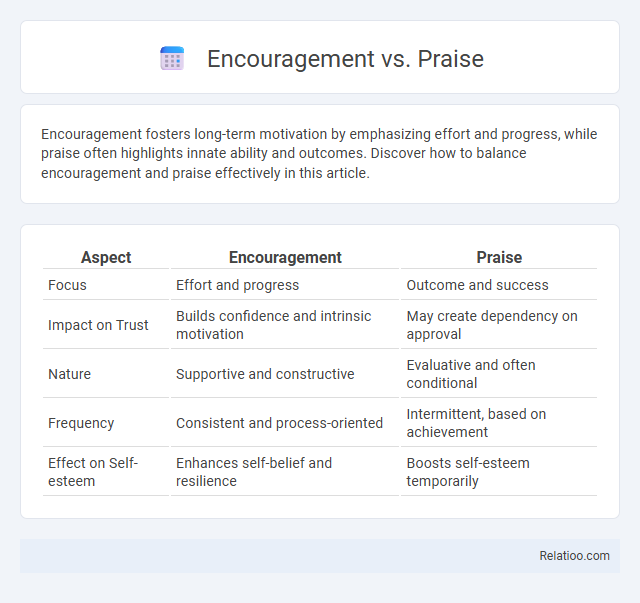Encouragement fosters long-term motivation by emphasizing effort and progress, while praise often highlights innate ability and outcomes. Discover how to balance encouragement and praise effectively in this article.
Table of Comparison
| Aspect | Encouragement | Praise |
|---|---|---|
| Focus | Effort and progress | Outcome and success |
| Impact on Trust | Builds confidence and intrinsic motivation | May create dependency on approval |
| Nature | Supportive and constructive | Evaluative and often conditional |
| Frequency | Consistent and process-oriented | Intermittent, based on achievement |
| Effect on Self-esteem | Enhances self-belief and resilience | Boosts self-esteem temporarily |
Understanding the Difference: Encouragement vs Praise
Understanding the difference between encouragement and praise is essential for fostering genuine motivation and growth. Encouragement focuses on effort and progress, highlighting your perseverance and resilience, while praise often centers on outcomes or innate abilities. By emphasizing encouragement, you nurture a growth mindset that drives continued learning and self-improvement.
The Psychology Behind Encouragement
Encouragement fosters intrinsic motivation by reinforcing effort and resilience, whereas praise often emphasizes outcomes, potentially leading to fixed mindsets. Psychological studies reveal that encouragement supports self-efficacy, enhancing perseverance during challenges and promoting long-term growth. Understanding this distinction helps in developing strategies that nurture positive behavioral and cognitive development.
The Effects of Praise on Motivation
Praise, when specific and focused on effort rather than innate ability, can significantly enhance motivation by fostering a growth mindset and promoting persistence. Overreliance on generic praise may lead to dependency on external validation, reducing intrinsic motivation and resilience in the face of challenges. Research shows that encouragement emphasizing improvement and strategy use cultivates long-lasting motivation more effectively than superficial praise.
How Encouragement Builds Resilience
Encouragement builds resilience by fostering a growth mindset, allowing you to view challenges as opportunities for learning and improvement. Unlike praise, which often emphasizes innate traits or outcomes, encouragement focuses on effort, strategy, and perseverance, reinforcing your ability to overcome setbacks. This mindset strengthens emotional endurance, helping you adapt and thrive in the face of adversity.
The Pitfalls of Over-Praising
Over-praising can lead to dependency on external validation, diminishing Your intrinsic motivation and self-esteem. Encouragement focuses on effort and progress, fostering resilience and a growth mindset, unlike empty praise that may create pressure to constantly meet high expectations. Understanding these differences helps avoid pitfalls, promoting healthier personal development and genuine confidence.
Encouragement for Lifelong Learning
Encouragement fuels lifelong learning by fostering resilience and intrinsic motivation, empowering you to embrace challenges and persist through setbacks. Unlike praise, which often rewards outcomes or specific achievements, encouragement focuses on effort, growth, and the learning process itself. Consistent encouragement builds a growth mindset essential for continuous development and adaptability in an ever-changing world.
Praise and Fixed vs Growth Mindset
Praise emphasizing innate abilities fosters a fixed mindset, causing individuals to avoid challenges and fear failure. Encouragement centered on effort and progress cultivates a growth mindset, motivating resilience and continuous learning. Strategic use of encouragement over praise supports adaptive behaviors and long-term achievement.
Practical Ways to Offer Constructive Encouragement
Offering constructive encouragement involves recognizing effort and progress while providing specific guidance to foster growth and resilience. You can highlight strengths and areas for improvement by using positive language that motivates without creating pressure. Practical ways include setting achievable goals, giving actionable feedback, and celebrating small successes to build confidence and sustain motivation.
When and How to Use Praise Effectively
Praise should be used strategically to reinforce specific behaviors and achievements, focusing on effort and improvement rather than innate traits to foster growth mindset. Effective praise involves timely, genuine, and specific feedback that highlights the individual's actions, which encourages continued motivation and skill development. Overusing praise or making it vague can diminish its impact, so it is essential to balance praise with constructive encouragement to promote resilience and long-term confidence.
Fostering Self-Esteem through Encouragement
Encouragement strengthens your self-esteem by focusing on effort and progress, promoting internal motivation and resilience. Praise often highlights fixed traits or outcomes, which can limit growth by creating dependence on external validation. Encouragement empowers individuals to embrace challenges and develop a healthier self-image based on their abilities and perseverance.

Infographic: Encouragement vs Praise
 relatioo.com
relatioo.com